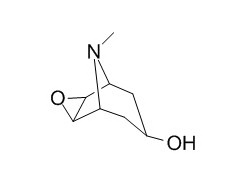Scopine
Scopine is the metabolite of anisodine, which is a α1-adrenergic receptor agonist. It is a potential brain-targeting moiety for enhancing the brain uptake efficiency of chlorambucil, and used in the treatment of acute circulatory shock.
Inquire / Order:
manager@chemfaces.com
Technical Inquiries:
service@chemfaces.com
Tel:
+86-27-84237783
Fax:
+86-27-84254680
Address:
1 Building, No. 83, CheCheng Rd., Wuhan Economic and Technological Development Zone, Wuhan, Hubei 430056, PRC
Providing storage is as stated on the product vial and the vial is kept tightly sealed, the product can be stored for up to
24 months(2-8C).
Wherever possible, you should prepare and use solutions on the same day. However, if you need to make up stock solutions in advance, we recommend that you store the solution as aliquots in tightly sealed vials at -20C. Generally, these will be useable for up to two weeks. Before use, and prior to opening the vial we recommend that you allow your product to equilibrate to room temperature for at least 1 hour.
Need more advice on solubility, usage and handling? Please email to: service@chemfaces.com
The packaging of the product may have turned upside down during transportation, resulting in the natural compounds adhering to the neck or cap of the vial. take the vial out of its packaging and gently shake to let the compounds fall to the bottom of the vial. for liquid products, centrifuge at 200-500 RPM to gather the liquid at the bottom of the vial. try to avoid loss or contamination during handling.
The University of Manitoba2021, 35690.
Anal Bioanal Chem.2016, 408(1):177-90.
Environ Toxicol.2024, tox.24246
BMC Plant Biol.2022, 22(1):128.
Saudi Pharm J2020, 10.1016
J Lipid Res.2024, 65(10):100640.
Phytomedicine.2018, 47:48-57
Nutrients.2022, 14(16):3393.
Univerzita Karlova2022, 173245.
J Hematol Oncol.2018, 11(1):112
Related and Featured Products
Bioconjug Chem. 2014 Nov 19;25(11):2046-54.
Scopine as a novel brain-targeting moiety enhances the brain uptake of chlorambucil.[Pubmed:
25350514]
The blood brain barrier (BBB) represents the biggest challenge for therapeutic drugs to enter the brain. In our study, we selected chlorambucil (CHL), an alkylating agent, as the model therapeutic agent, and used Scopine as a novel brain-targeting moiety.
METHODS AND RESULTS:
Here, we synthesized Chlorambucil-Scopine (CHLS) prodrug and evaluated its brain-targeting efficacy. The tissue distribution study after i.v. injection revealed that the AUC0-t and Cmax of CHLS in the brain were 14.25- and 12.20-fold of CHL, respectively. Specifically, CHLS accumulated in bEnd.3 and C6 cells in an energy-dependent manner. In C6 cells, superior anti-glioma activity with a significantly decreased IC50 of 65.42 nM/mL was observed for CHLS compared to CHL (IC50 > 400 nM/mL). The safety evaluation, including acute toxicity, pathology, and hematology study, showed minimal toxicity toward nontargeting tissues, and also reached a lower systemic toxicity at 5 mg/kg (i.v.).
CONCLUSIONS:
Our results suggested that Scopine is a potential brain-targeting moiety for enhancing the brain uptake efficiency of CHL.
Chemphyschem. 2013 Jun 24;14(9):1830-5.
The distorted tropane of scopoline.[Pubmed:
23640872]
The structural isomerization of Scopine into scopoline (oscine) has been observed in a supersonic jet expansion using microwave spectroscopy.
METHODS AND RESULTS:
The rotational spectrum evidences a single structure in the gas phase, providing a first description of the (three-ring) structurally distorted tropane in scopoline. The absence of rotational signatures of any Scopine conformation suggests a practically quantitative isomerization at the vaporization temperatures of the experiment (ca. 90 °C). The determined rotational parameters of scopoline reveal the structural consequences of the intramolecular cyclation of Scopine, which breaks the original epoxy group and creates a new ether bridge and a 7β-hydroxytropane configuration.
CONCLUSIONS:
The hydroxy group further stabilizes the molecule by an O-H⋅⋅⋅N intramolecular hydrogen bond, which, in turn, forces the N-methyl group to the less stable axial form.
Supporting ab initio (MP2) and DFT (B3LYP, M06-2X) calculations are included.



